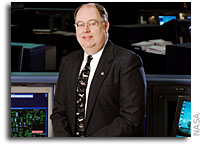Friday Flight Director Story

STS-37 carried one of NASA’s “Great Observatories”. In case you had forgotten, the Hubble Space Telescope is not up there by itself. While Hubble peers at the universe in the visible light spectrum, a huge amount of information can be gathered from observations in the parts of the electro-magnetic spectrum that are invisible to humans. The Chandra X-ray telescope looks at, well, X-ray pictures of the universe. The Spitzer Infrared telescope looks at thermal images of the universe, and the Compton Gamma Ray telescope looked for very high energy signatures. Sadly Compton is the only one of the great observatories no longer with us — another story for another day — but son-of-Compton, the Fermi GLAST observatory carries on with observations in this strange part of the spectrum.
Compton was a huge advance and a large scientific instrument. But like every other payload, weight is everything when you are trying to get out of Earth’s gravity well. In an effort to provide the maximum mass to the scientific instruments, the spacecraft bus weight was cut to a minimum. In particular, the solar arrays — vital to generate the power for observatory — were somewhat flimsy; especially the mechanism to extend them.
Lead Flight Director Chuck Shaw recognized this as a potential problem area early on and had his team develop a set of EVA procedures and tools to manually extend the solar arrays if the mechanism failed. Lots of time was spent practicing these maneuvers in the water tanks. Just to complete the exercise, the team looked at other parts of the Compton which might need a little human help and rounded out the crew procedures and training so that any of those could be handled as well.
As Ascent/Entry Flight Director on STS-37, I sat next to Chuck during the deploy operations. The A/E FD is always interested to see if the “CG Management Device” (aka, the primary payload) really got out of the bay or not.
Deploy operations are always tense and this was no exception. The Compton had only limited battery life for the time when it was disconnected from the shuttle power supply until it was lifted out of the bay on the robot arm and could extend its solar arrays and make power on its own. The EVA crewmembers, Jerry Ross and Jay Apt, were in their suits in the airlock with hatches closed waiting word to go out and extend those solar arrays or stand down from EVA and get out of the suits.
We were breathless as the Goddard Payload Control center sent the command to extend the first solar array. With the speed of light the command traveled down the T1 terrestrial circuit from Maryland to Houston where it was electronically woven into the digital uplink of command and voice, forwarded over another T1 circuit to White Sands New Mexico where the antennas bounced the command to the Tracking and Data Relay Satellite hovering in geosynchronous orbit over the equator, then from the TDRS down to the shuttle in low earth orbit, finally from the shuttle into Compton where the little electric latches and motors were waiting. All this is a fraction of a second, and we waited to see the array extend. Breathless.
Success! First one array and then the other extended and locked into flight configuration and the power began to flow. We could breath again. The EVA crew began to feel disappointment; probably no space walk today. But not quite yet. Time to deploy the high gain antenna that would beam Compton’s scientific data to the ground. This was a robust mechanism and we really didn’t worry much as the Goddard Payload Control issued the high gain antenna deploy command.
Nothing happened. Ooops. Check the circuit breakers, make sure the command was in the right format, make sure the comm link was good, try again. Nothing.
Looks like you guys are going EVA after all. Music to a spacewalker’s ears! So out the door went Jerry and Jay and in a matter of a few minutes they released the antenna and life was good.
As I say, my only interest was whether they were going to get that big rock out of my shuttle payload bay or not. Not really. We learned a tremendous amount from Compton. There were more adventures ahead, both for that robotic observatory and for the shuttle on STS-37 — stories for another day.
So, what can we learn? (There is always a moral to these stories).
1. It is good to be prepared. The tools were ready, the team had practiced, the procedures had been vetted; it all worked smoothly. I have been in other circumstances where there was a lot of “broken field running” and its not pretty.
2. It pays to have a fixit man handy when your complex gizmo has a glitch. I don’t remember how much Compton cost, we certainly got its worth paid for in scientific data and improvement in understanding of the universe. We found out a lot about Gamma Ray bursters and where they are (or aren’t). But all that money would have been wasted if that antenna had been stuck. Spaceflight is like that. All or nothing, rarely anything in the middle.








